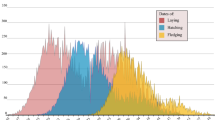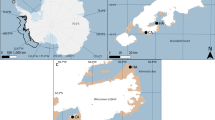Abstract
The northern fulmar (Fulmarus glacialis) is a common seabird of the North Atlantic Ocean, with breeding colonies broadly dispersed between 45°N and 80°N. At higher latitudes, breeding fulmars experience extensive sea-ice and presumably snow and low temperatures which do not affect fulmars in the southern part of the breeding range. We studied the relationship between weather and reproductive success of northern fulmars breeding at two colonies in the Canadian high Arctic. Collectively, hatching success, fledging success, and productivity (chicks fledged per egg laid) were similar between our study and results from colonies located south of the Arctic. However, a larger proportion of fulmars at apparently occupied sites (AOS) in high Arctic colonies appeared to forego egg-laying, resulting in lower proportions of chicks fledged per AOS. Extreme inclement weather was the major factor influencing nesting success, resulting in pulses of egg or chick loss during or immediately following major storms, although the mechanism of effects appeared to differ between the two colonies. For Arctic fulmars, the risks of nest failure due to stochastic, deleterious weather events may be offset by the predictable abundance of food supplies during chick-rearing in Arctic waters.




Similar content being viewed by others
References
ACIA (2005) Arctic climate impact assessment. Cambridge University Press, Cambridge
Barbraud C, Chastel O (1998) Southern fulmars molt their primary feathers while incubating. Condor 100:563–566
Creuwels JCS, van Franeker JA, Doust SJ, Beinssen A, Harding B, Hentschel O (2008) Breeding strategies of Antarctic petrels Thalassoica antarctica and southern fulmars Fulmarus glacialoides in the high Antarctic and implications for reproductive success. Ibis 150:160–171
Dunn PO, Thusius KJ, Kimber K, Winkler DW (2000) Geographic and ecological variation in clutch size of tree swallows. Auk 117:215–221
Dunnet GM, Ollason JC, Anderson A (1979) A 28-year study of breeding fulmars Fulmarus glacialis in Orkney. Ibis 121:293–300
Falk K, Møller S (1997) Breeding ecology of the fulmar Fulmarus glacialis and the kittiwake Rissa tridactyla in high-arctic northeastern Greenland, 1993. Ibis 139:270–281
Fisher J (1952) The fulmar. Collins, London
Fortescue M (1999) Temporal and spatial variation in breeding success of the little penguin Eudyptula minor on the east coast of Australia. Mar Ornithol 27:21–28
Furness RW, Camphuysen CJ (1997) Seabirds as monitors of the marine environment. ICES J Mar Sci 54:726–737
Gaston AJ, Gilchrist HG, Mallory ML (2005) Variation in ice conditions has strong effects on the breeding of marine birds at Prince Leopold Island, Nunavut. Ecography 28:331–344
Gaston AJ, Mallory ML, Gilchrist HG, O’Donovan K (2006) Status, trends and attendance patterns of the northern fulmar Fulmarus glacialis in Nunavut, Canada. Arctic 59:165–178
Gray CM, Phillips RA, Hamer KC (2003) Non-random nestling mortality in northern fulmars: implications for monitoring marine environments. J Zool (Lond) 249:109–113
Hatch SA (1987) Adult survival and productivity of northern fulmars in Alaska. Condor 89:685–696
Hatch SA, Hatch MA (1990) Components of breeding productivity in a marine bird community: key factors and concordance. Can J Zool 68:1680–1690
Hatch SA, Nettleship DN (1998) Northern fulmar (Fulmarus glacialis). In: Poole A, Gill F (eds) The birds of North America, No. 361. The Birds of North America Inc., Philadelphia
Hodum PJ (2002) Breeding biology of high-latitude Antarctic fulmarine petrels (Procellariidae). J Zool (Lond) 256:139–149
Koenig WD (1982) Ecological and social factors affecting hatchability of eggs. Auk 99:526–536
Linton A, Nettleship DN (1977) Biological investigation of northern fulmars (Fulmarus glacialis) at Prince Leopold Island, NWT, summer 1976. Studies on Northern Seabirds Report No 53. Available from Environment Canada, Sackville, NS
Lloyd CS, Tasker ML, Partridge K (1991) The status of seabirds in Britain and Ireland. T&AD Poyser, London
Mallory ML (2006) The northern fulmar (Fulmarus glacialis) in Arctic Canada: ecology, threats, and what it tells us about marine environmental conditions. Environ Rev 14:187–216
Mallory ML, Forbes MR (2005) Sex discrimination and measurement bias in northern fulmars (Fulmarus glacialis) from the Canadian Arctic. Ardea 93:25–36
Mallory ML, Forbes MR (2007) Does sea-ice constrain the breeding schedules of high Arctic northern fulmars? Condor 109:895–907
Mallory ML, Gaston AJ (2005) Monitoring northern fulmars in the Canadian arctic: plot locations and counts at selected colonies. Canadian Wildlife Service Technical Report 432
Mallory ML, Akearok J, Edwards DB, O’Donovan K, Gilbert CD (2008) Autumn migration and wintering of northern fulmars (Fulmarus glacialis) from the Canadian high Arctic. Polar Biol 31:745–750
Mavor RA, Parsons M, Heubeck M, Schmitt S (2005) Seabird numbers and breeding success in Britain and Ireland, 2004. Joint Nature Conservation Committee, Peterborough
Mougin J-L (1967) Etude ecologique des deux especes des fulmars: le fulmar Atlantique (Fulmarus glacialis) et le fulmar Antarctique (Fulmarus glacialoides). Oiseau 37:57–103
Nettleship DN, Gaston AJ (1978) Patterns of pelagic distribution of seabirds in western Lancaster Sound and Barrow Strait, Northwest Territories, in August and September 1976. ESCOM Report No AI–09, Environment Canada, Ottawa
Ollason JC, Dunnet GM (1988) Variation in breeding success in fulmars. In: Clutton-Brock TH (ed) Reproductive success. University of Chicago Press, Chicago, pp 263–278
Salomonsen F (1965) The geographical variation of the fulmar (Fulmarus glacialis) and the zones of marine environment in the North Atlantic. Auk 82:327–355
Swennen C (1974) Observations on the effect of ejection of stomach oil by the fulmar Fulmarus glacialis on other birds. Ardea 62:111–117
Systat Software Inc. (2002) Systat 10.2. Systat, Richmond
Thompson PM, Ollason JC (2001) Lagged effects of ocean climate change on fulmar population dynamics. Nature 413:417–420
Trivers RL (1972) Parental investment and sexual selection. In: Campbell B (ed) Sexual selection and the descent of man 1871–1971. Aldine, Chicago, pp 136–179
Warham J (1990) The petrels-their ecology and breeding systems. Academic Press, London
Welch HE, Bergmann MA, Siferd TD (1992) Energy flow through the marine ecosystem of the Lancaster Sound region, Arctic Canada. Arctic 45:343–357
Welty JC, Baptista L (1988) The life of birds, 4th edn. Harcourt College Publishers, Toronto
Acknowledgments
All research was conducted under approved permits as follows: animal care (2004PNR017, 2004PNR021), land use (59A/7-2-2), wildlife research (NUN-SCI-00-04, NUN-SCI-03-02, WL000714). Many collaborators made the Cape Vera and Prince Leopold Island projects possible in 2000–2005, and in particular J. Akearok, T. Arsenault, J. Berge, S. Chisholm, D. Edwards, C. Eberl, C. Ferguson, A. Fontaine, A. Moenting, B. Newton, K. O’Donovan, M. Robertson, K. Truman, and K. Woo. J. Creuwels, S. Hatch, and two anonymous referees provided insightful reviews of the manuscript. Financial and logistic support were provided by Environment Canada (CWS, NEI), Natural Resources Canada (PCSP), the Nunavut Wildlife Management Board, Indian and Northern Affairs Canada (NSTP), and Carleton University.
Author information
Authors and Affiliations
Corresponding author
Rights and permissions
About this article
Cite this article
Mallory, M.L., Gaston, A.J., Forbes, M.R. et al. Influence of weather on reproductive success of northern fulmars in the Canadian high Arctic. Polar Biol 32, 529–538 (2009). https://doi.org/10.1007/s00300-008-0547-4
Received:
Revised:
Accepted:
Published:
Issue Date:
DOI: https://doi.org/10.1007/s00300-008-0547-4




